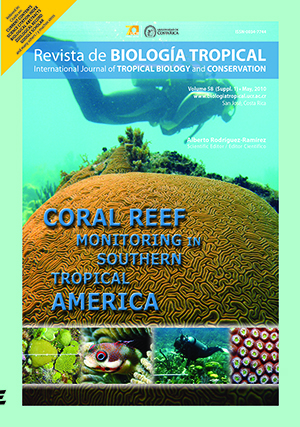Abstract
The health of coral reef communities has been decreasing over the last 50 years, due the negative effects of human activities combined with other natural processes. We present documentation of a White Plague Disease (WPD) outbreak in the Serrana Bank, an isolated Western Caribbean atoll with presumably inexistent pollutant inputs from local human settlements. In addition, this study summarizes seven years of observations on diseased corals in the nearby island of San Andrés, which in contrast is one of the most populated islands of the Caribbean. There was a massive coral mortality in the atoll lagoon (14°27’53.24”, 80°14’22.27” W, and 12m depth) due to WPD on May 4 of 2003. Seventeen species were found dead or largely affected by the disease. The information resulting from GPS and manta-tow transects revealed that approximately 5.8ha of reticulate Montastraea spp. patch reefs were lethally affected by the disease in the atoll. On May 8 of the same year we observed and calculated a mean coral cover of 7.03% (SD± 2.44), a mean diseased coral tissue cover of 5.5% (SD± 1.1) and a 13.4% (SD± 8.05) of recently dead coral covered with a thin filamentous algae layer; approximately 73% of mortalities caused by the disease occurred before the end of the outbreak. A rough estimate of 18.9% in recent coral cover reduction can be attributed to WPD. This represents about 82% of the total coral cover decline since 1995. Semi-enclosed environments such as atoll lagoons and the reticulate patch-reefs of Montastraea spp. seem to be particularly vulnerable to this kind of coral disease, which constitute an alert to increase the monitoring of the same kind of atoll environments. The WPD has been present in the area of the nearby island of San Andrés at a low prevalence level, with sporadic increasing peaks of disease proliferation. The peaks observed during 1999 and 2004 comprised increases of 266% and 355% respectively, suggesting an alarming progression of the disease in this area. This study includes new information of the epizoolotiology of White Plague Disease and documents the permanent prevalence and progression of the WPD in the area of San Andres Island.Comments

This work is licensed under a Creative Commons Attribution 4.0 International License.
Copyright (c) 2010 Revista de Biología Tropical
Downloads
Download data is not yet available.






